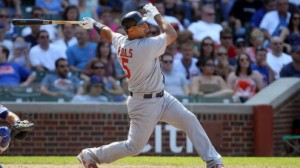With Bodog closing their future’s betting for the season, we are left with Sportsbook as our new provider of future’s bets, for this preview and the remaining NL West preview. We’ll take a look here at the most wide open division in baseball. All three of the top teams have legitimate division crown hopes, and the bottom three teams offer the greatest host of teams that have no chance of making any waves of any sort at all.

Cincinnati Reds
Odds of Winning World Series: +2500
Odds of Winning NL Pennant: +1200
Odds of Winning NL Central: +180
2010: 91-71, 1st in NL Central
What can you say about a team with a disastrous scouting track record that led to years of mediocrity and whose fortunes have suddenly changed in the past few seasons? The Reds had one of the most horrid runs of major league picks seen in a long time, drafting a host of players between 1986 and 2003 that either did not reach the majors or had brief unsuccessful stints. The sole exception was Pokey Reese in 1991; all other first round picks could be deemed failures. Part of the shortcomings can be attributed to the team’s inability or unwillingness to spend on signing bonuses for draft picks, but since 2003, the team has steadily climbed from 24th in MLB Rank for spending on draft picks to 16th last season. It has paid off handsomely.
How big has the turnaround been since 2003? Consdering that 4 of their 6 starting pitchers were home grown talents and that only two (Bronson Arroyo and Edinson Volquez) of the possible rotation candidates have ever spent time in a non-Reds uniform, it becomes very apparent that the Reds have done an excellent job of developing pitching prospects.
Other than their pitching, they also have a host of position players coming up through the ranks. Despite signing Edgar Renteria in 2004, the Reds have a second prospect (Paul Janish was snubbed in essence by Renteria) in Zack Cozart. Cozart’s potential make him a near lock to be part of the upcoming 2011 version of the “Big Red Machine.” Cincinnati has the pieces in tact for a strong dynasty and there’s no reason that they won’t contend for the next 5 to 8 seasons. Even if a wave of injuries did hit, they have enough replacement talent waiting in the minors to amply fill the holes. Indeed, things are rosy for the Reds.
St. Louis Cardinals
Odds of Winning World Series: +3000
Odds of Winning NL Pennant: +1500
Odds of Winning NL Central: +300
2010: 86-76, 2nd in NL Central
There really isn’t a case of a team that has done so much with so little (payroll & market size) than the St. Louis Cardinals. Since 2001, they have won 904 games, more than all teams other than the Yankees & Red Sox and they have made 7 playoff appearances, two World Series, and a championship in 2006.
Their payroll is roughly one half as big as the Red Sox’s and but a fraction of the colossal spending employed by baseball’s most hated team in the Yankees. The only teams to pay less in payroll have been the Minnesota Twins (who are now spending more money) and the Oakland Athletics (who are desperate for a new stadium and aren’t bringing in the necessary revenue to pay big salaries). The result of this success has been very obvious. The Cardinals drew 32 million fans in the last decade, the third highest total in baseball.
Despite the continued success, there is reason for pessimism among Cardinal fans. The team faded horribly toward the end of last season, propelled by a 2-8 road trip against the Pirates, Nats, and Astros, and allowed the Reds to squeak by with a 5 game lead at the end of the season, leading up to the ultimate disappointment of being swept by the Reds in the NLDS.
The most tenuous situation with the Cards, however, has to be Albert Pujols. Since 2001 when he won ROY, he has been one of the best players in baseball, winning three MVP awards and hitting more home runs than anyone else in the majors over that span (42 last season, 47 in 2009, and 37 in 2008. The PECOTA projections in Baseball Prospectus predict Pujols to have another typical season for himself, with his projected home runs at 41 and his batting average predicted to be .322, .10 higher than he hit last season; after all, the .312 he posted last season was the lowest of his major league career — and it was still very solid. However, Pujols is now 31, and a decline may be expected in the next few seasons and be that as it may, he’ll still be worth every penny of the inevitably huge contract that is going to be extended to him.
The problem for the Cardinals, however, is that resigning their stud is going to hamper their payroll and leave little wiggle room for signing bonuses to prospects (of utmost importance as evidenced by other examples, even in their division such as the Reds) and spending on free agents, which is obviously always another crucial element in filling holes to build a championship team. The situation will likely mirror that of the Miami Heat in the NBA, a team built around three studs (Pujols, Adam Wainright, and Matt Holiday) and the rest of the roster filled out with stop gap “scrubs,” players that are easily replaceable should they struggle.
For now, the present is bright for the Cards, but the future is clouded in questions. The approach the Reds take towards handling Pujols’ contract situation will be crucial and baseball fans will be waiting with baited breath to see just how Cardinals management will manage to build a team around 3 superstars.
Milwaukee Brewers
Odds of Winning World Series: +1500
Odds of Winning NL Pennant: +700
Odds of Winning NL Central: +180
2010: 77-85, 3rd in NL Central
The Brewers continue to serve as proof that a high powered offense is no substitute toward having a defense that can actually prevent runs. Since the departure of C.C. Sabathia and the injury plagued and ended career of Ben Sheets, the Brewers have regressed mightily since 2008, when they were the best team in baseball at run prevention. In the three off seasons since that time, they have continually made their efforts to shore up their shoddy pitcher situation, as well as acquring strong infield defenders, but those efforts have by and large failed.
The imbalance really couldn’t be any more pronounced than it is. In the 2009 & 2010 seasons, Brewers hitters produced a 497.1 VORP, the third highest in the league, only to see their pitchers finish dead last with an absurdly low VORP of 73.2 (Baseball Prospectus, 2011). The disparity makes the Brewers the most offensively tiilted and dominant team since 1954, with only the 68-69 Cardinals and the 76-77 Reds having a bigger gap between their hitters’ VORP and their pitchers’ VORP.
Compare the disparity and imbalance to a team like the Giants, the reigning champs. The Giants don’t have the pop from the bat that the Brewers had, but they have enough. Their VORP balances out to 280.2 from their pitchers and 171.6 VORP from their hitters. Such balance is what drives championships and until the Brewers make some moves to trade their offensive studs for either pitchers or stronger fielders (less likely), they are going to continue to plug away at respectability but never at dominance. And it will have to come through trades because the Brewers have little cheap help coming through the minor leagues, and their last great hope for a top notch pitcher from their farm system was dashed by the perfect example of their stereotypical failures in Manny Parra.
The frustration has only been fueled by expensive failures on the free agent market. Jeff Suppan (2007), David Riske, and Eric Gagne combined to produce an array of injuries and ineffectiveness and have rendered the Brewers’ payroll to the point of near inflexibility, something that promises to hang a dark cloud over the franchise until the contracts expire or the players are dealt for pennies on the dollar. Throw in the fact that the Brewers spent $7.5 M on Doug Davis and LaTroy Hawkins, who combined for a -20.0 VORP in 54.1 innings. Failure just doesn’t get much more pronounced than that. In fact, in summation, the Brewers have spent $42 M on free agent pitching and the VORP return was -15.6. For those unfamiliar with VORP, a negative number indicates a player that is not worth his weight in fecal matter, to place the matter in inequivocably benign terms. Such is the case with the Brewers’ pitching, though, and until they totally revamp the team and begin to trade some of their offensive studs for pitching, they are going to continue to be little more than an exciting bad team.
Houston Astros
Odds of Winning World Series: +10000
Odds of Winning NL Pennant: +4000
Odds of Winning NL Central: +4000
2010: 76-86, 4th in NL Central
For as stacked as the odds on Sportsbook are against the Astros, it’s hard to understand exactly why. Sure, the team finished 10 games below .500 and a solid 15 games back from the division leading Reds, but consider the fact that they were 36-26 from July 27th until the end of the season, and one can begin to see the reason for hope among Astros fans, players, and management.
Teams that finish strongly often don’t receive proper credit from oddsmakers, making a highly speculative bet on the Astros winning the division not a bad idea, especially given the +4000 line on the Astros winning the division. The NL Central is one of the few division that is pretty much wide open, though, and even the favored Reds are +180, indicating there is no team in the negative with a strong chance of outright domination. Perhaps fortunately, few expect much from the Astros, making the odds a good payout for a team that could turn things around as quickly as this year. Afterall, when they closed the season with the third best record over the stretch span, they signified that they may have the players in place to turn things around. And while the bet may be a bit of a long shot, the potential payout does make it enticing for a small speculative bet at least.
As upbeat as one can get, there is again like most under .500 teams, a reason for their relative failure, or lack of ultimate success, rather. The Astros are a team that prides themselves on being defensive stoppers and their 4.50 runs allowed per game ranked 11th; not exactly as elite as one might hope for from a team built in that respect. Moreover, they ended up with only a .680 defensive efficiency rating, which was only good enough for 13th best in the league. What these stats clearly indicate is that, contrary to their perceived image and design for the team, they are quite average in defense, and their offense just doesn’t produce the necessary firepower for this team to merely be average in defensive categories. Their on base and slugging percentages were the absolute lowest in the majors. However, since hiring Wade to handle the prospects, they do have a host of talent at the lowest levels in the minors, which may or may not eventually pan out in the case of prospects such as Vincent Velasquez, Delino DeShields Jr., Mike Kvasnicka, and J.D. Martinez
The Astros are not without some pitching standouts, however. Brett Myers and Wandy Rodriguez (perhaps the most pleasant surprise for the Astros last year) are good upper tier starting pitchers, while J.A. Happ and Bud Norris showed flashes of promise. Beyond those successes, they also have a blue chip pitching prospect in Jordan Lyles, who is about the only big name prospect in the minors for the Astros. And for all Lyles’ upside, he isn’t projected to be much more than a typical 3rd starter…and that is the BEST prospect they have. Certainly, their farm system is one of the worst in the majors.
So what of the future for the Astros? Well, as many know, they are saddled with a horrible contract in Carlos Lee. Lee’s VORP was a pathetic 1.3, which is beyond unacceptable for a player that is supposed to be a franchise cornerstone. In fact, quite amazingly, four Astros PITCHERS had a higher offensive VORP than Lee. Lee’s contract expires in two seasons, but not before the Astros shell out another ridiculous $37 Million to him. Until the expiration of Lee’s contract, it will be difficult for the Astros to maneuver much at the major league levels, and their farm system is still a few years from being a viable contributor to their major league roster.
Chicago Cubs
Odds of Winning World Series: +3000
Odds of Winning NL Pennant: +1500
Odds of Winning NL Central: +450
2010: 75-87, 5th in NL Central
The Cubs, over the last 10 to 12 years, have finally shed the horrible labels that followed them after years and years of futile attempts to even remain competitive. They have won 4 Pennants over the last 12 years, in 1998, 2003, 2007, and 2008 and are finally giving the fans in Wrigley Field a reason to do more than drink beer and throw home runs back onto the field. The Cubs have done everything possible to please the fan base by assembling teams for a run and then if they fail, quickly disassembling, reloading, and trying for another run at a title. This year promises to be a repeat performance of that, and the odds for the Cubs winning a title are much greater than one would expect from a team that finished near the bottom of the division standings and finished a full 16 games back from the division leading Reds.
For the first time in years, however, the Cubs may not be entirely dependent upon trades and free agent signings to bolster their team. Their farm system is strong, and scouting director Tim Wilken and farm director Oneri Fleita have done their best to develop a host of prospects that will finally render the Cubs with some homegrown talent. Heading their class of young talent is Starlin Castro, who has already drawn comparisons to Edgar Renteria, and he may be a better all around hitter than Renteria, which truly says something about his talents. Couple Starlin with their top pick in 2009, Brett Jackson, who stole 30 bases and had 60 extra base hits, and the Cubs have a duo of potential superstars that will propel them to the top — eventually. And adding to this they also have another outfielder in Tyler Colvin who showed in 2010 that his power in his rookie year was no anomaly or accident.
Beyond the domestic products that the Cubs have selected, they have also done their homework in Japan and Latin America, signing a host of talents that will man the infield for years to come. It’s a serious boon for a team that has committed millions to a handful of Cubs and is crippled in terms of free agent additions or other salary increasing moves. After the expiration of a number of bad contracts (Kosuke Fukudome, Carlos Silva, Aramis Ramirez [if the Cubs buy him out], Ryan Dempster, and Carlos Zambrano [team option]), the Cubs will have both the money to spend and the developed prospects to field a contending team. In fact, given the wide open nature of the NL Central, the Cubs have a decent chance at winning the division — now.
Pittsburgh Pirates
Odds of Winning World Series: +10000
Odds of Winning NL Pennant: +5000
Odds of Winning NL Central: +10000
2010: 57-105, Last (6th) in the NL Central
The Pirates have been making history. Unfortunately, for Pirates fans, players, and management, the history making has been of the negative variety. The Pirates managed to set a futility record not only for baseball, but for all of the major league American sports, finishing with their 17th consecutive sub .500 season. And the worst part is there doesn’t seem to be any light at the end of the tunnel. Even after receiving a brand new beautiful stadium in PNC Park, the team still has few things to be excited about. Their 105 losses last year represented the worst Pirates season since 1952, a team that managed to win 15 games fewer than their current pathetic squad.
So what’s better – the Pirates defense or their offense? Trick question. They finished at the bottom of the league in both runs scored and they had the worst efficiency record on defense of any team, too, with a .673 rating. So, yes, they are horrible in hitting, pitching, and team defense and have almost no prospects of winning given the ownership’s perpetual lack of spending and lack of team support in Pittsburgh.
Is there any reason for hope at all? Maybe a little. They recently brought in manager Clint Hurdle, who in 2007 had turned a team in the Rockies from last in their division to a trip to the World Series. As improbably and optimistic as it may sound, Pirates fans are hoping he can do the same with their floundering franchise. Beyond this, the Neal Huntington, the teams GM, seems to have assembled a host of young players, both traded for and drafted, that could provide the kind of cheap help that a small market team like the Pirates depends on. Jose Tabada, Neil Walker, Pedro Alvarez, Andrew McCutchen, and Tony Sanchez all provide hope of happier days for Pirate fans, and long after the talents have developed and left for greener pastures and more money, Pirates’ fans may at least have a couple of winning seasons to savor in their memories, which is about the most can ask from a team that has been perpetually crippled, fighting a losing war to which there is probably no real end. Evidenced by their ridiculous odds, the Pirates offer no betting prospects as anything other than another last place finish in the NL Central seems inevitable.














